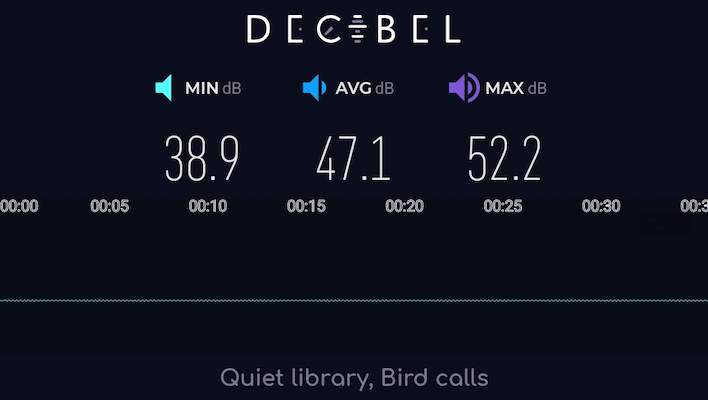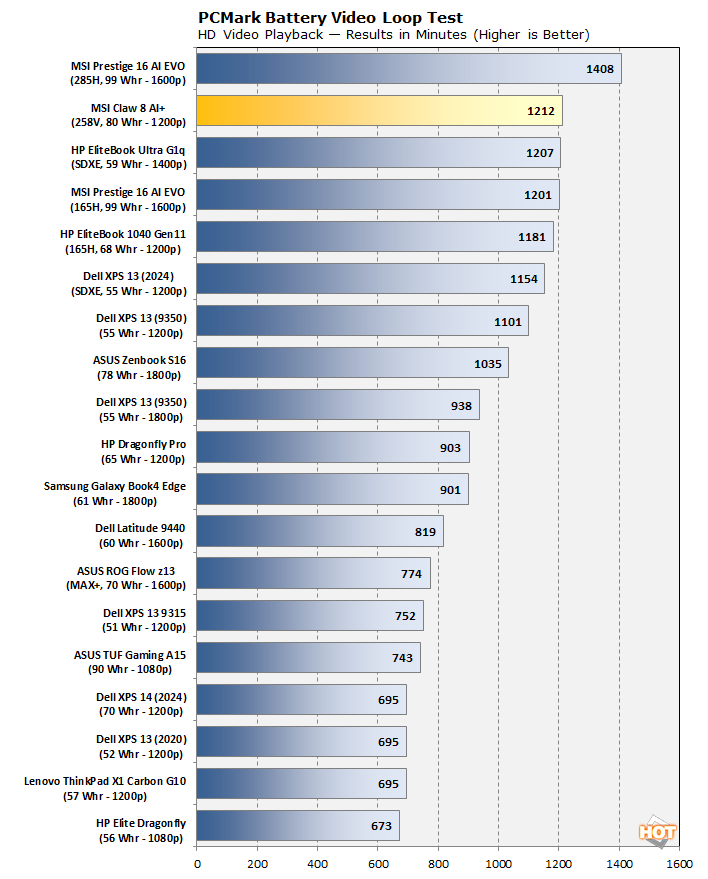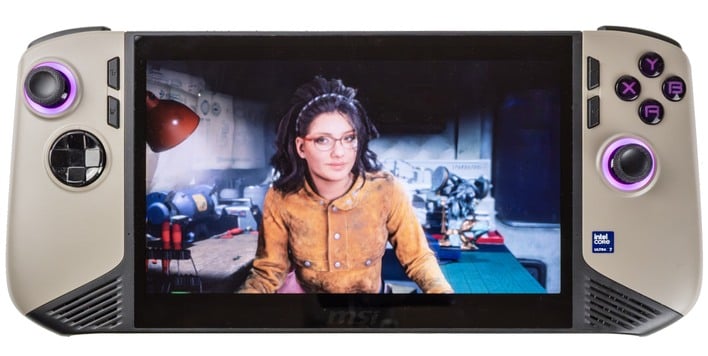MSI Claw 8 AI+ Review: Plush And Premium Handheld Gaming

That 52-decibel peak was during one short period when the fans ramped up unusually high for unclear reasons during a constant workload. Other that that, this hand-held gaming device hovered right around the 46-49 decibel level, which is audible but unoffensive. It's pretty impressive considering how noisy certain other handhelds can get, and especially considering that we never saw this machine approach its thermal limits in testing.

According to HWiNFO, the highest temperature we ever saw on the SoC was a relatively cool 80℃. Considering the max temperature for these chips is a full 100 degrees, we think you're going to be power limited way before you are ever thermal limited in the Claw 8 AI+. Skin temperatures remain quite cool as well. and the machine nevesir feels anything more than slightly warm to the touch.
MSI Claw 8 AI+ Battery Life Testing
Battery life is almost always a sore spot for handhelds. Gaming on the go wants a lot of power, and PC gaming is primarily targeted at more powerful desktop systems that can burn as much power as the user is willing to pay for. Flipping that paradigm on its head to enable portable PC gaming has been a challenge, and it's one the industry still hasn't exactly solved. Hybrid game consoles like the Nintendo Switch absolutely destroy even the most long-lived handhelds, in terms of battery life. So how does the Claw 8 AI+ do?
In the PCMark Battery Video Loop test, which loops a 1080p video endlessly until the battery runs itself down, the Claw 8 AI+ lasted over twenty hours. That is an almost unbelievable result for a gaming handheld, but it's not too surprising in the context of this system's specs. The Claw 8 AI+ has a Core Ultra 200V-series CPU onboard, which are known to be extremely efficient when needed, and this device also has a massive 80-Whr battery.
With the screen calibrated to 110 nits (26% brightness), you can literally watch local videos all day long and then some on the Claw. Most people probably aren't buying this system to watch videos, though; so wow long does it last when playing games? Let's do another head-to-head and find out:

The Claw 8 AI+ put a bit of a mixed bag of results, but overall, the answer is that it's gaming battery life is slightly worse than the ASUS ROG Ally X. That's not bad at all. The ROG Ally X has the best battery life on the market bar none for a PC gaming handheld, and the Claw 8 has a bigger, brighter, and higher-resolution display as well as a bigger and generally faster graphics engine. Relatively speaking, these results are actually solid. 242 minutes is four full hours of playing Holocure: Save the Fans in native 1200p resolution at 60 FPS. 154 minutes is two and a half hours of Devil May Cry V—an amount no one has actually ever been able to play in one sitting before their hands cramp. (We kid, sort of.)
Altogether, when taken in the context of "portable devices," battery life on the Claw 8 AI+ could probably be better, sure—but in the context of what it is and what it's doing, it's pretty great. We can't complain about getting over four hours of Fortnite on the go on this machine's gorgeous IPS variable refresh rate display.
MSI Claw 8 AI+ Gaming Handheld Powered By Intel Lunar Lake: Our Final Thoughts
We came into this review with high expectations—perhaps unfairly so. We were impressed by Lunar Lake in laptop form, and the original Claw handheld (which we have tested extensively, though we didn't get a chance to review it) had a lot going for it despite its flaws. In fact, most of those exact flaws were down to the choice of SoC that it employed, and replacing the power-hungry Meteor Lake chip with Intel's thrifty Lunar Lake processor has essentially resolved basically every complaint we could levy at the original MSI Claw.Despite our high expectations, the MSI Claw 8 AI+ exceeded many of them. It's not flawless and we do have some complaints, but almost all of them boil down to "we would have liked" rather than "we had a problem with..." Intel's graphics drivers are a minor sore spot. They're drastically improved from where they were two years ago, but there is still some work to be done. The lack of a kickstand is a bummer, and the complete inability to configure the Desktop mode controls isn't great. And that's about it for the shortcomings we did find.
Meanwhile, this system offers top-class handheld gaming performance and battery life in a no-fuss package with many nice-to-haves. You get dual Thunderbolt 4 ports for powerful external connectivity, you get VRR support on the display (which really helps with inconsistent handheld framerates), and you get 32GB of RAM, allowing you to assign as much as 16GB to the GPU alone. Hall-effect joysticks mean that you'll never have to worry about drift or mechanical failure, and the capable cooling solution on board this device keeps things chilled while staying quiet.
Really, the only sticking point for most people is going to be the price. At $899, MSI has priced the Claw 8 AI+ $100 over the already expensive ROG Ally X. It's more capable than that machine in lots of ways—it has a faster GPU, it has a much more powerful NPU, a larger screen and so on. Whether those factors are enough to convince you to shell out the extra hundred bucks for the Claw 8 is going to be up to you, though.

MSI Claw 7 AI+ Gaming Handheld: $799 at Amazon
For our money, we think this sits in the top tier of gaming handhelds on the market currently, along with devices like the Ayaneo Kun, the ROG Ally X, and the Lenovo Legion Go. This year we'll see a fresh fleet of devices sporting the latest-generation AMD chips, though, and Qualcomm is joining the fray too with its Snapdragon G SoCs. We might even see new handhelds based on Intel's Panther Lake. It will be fascinating to watch what the handheld market looks like around Christmas 2025. For now, if you want a true PC gaming experience on the go, you won't be disappointed with the MSI Claw 8 AI+.








